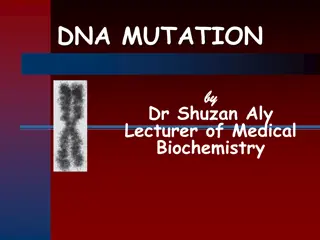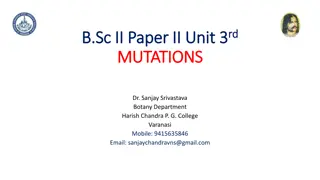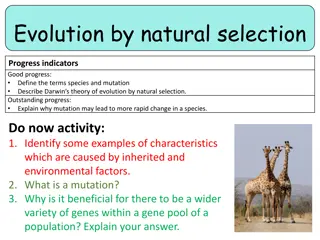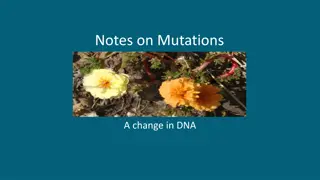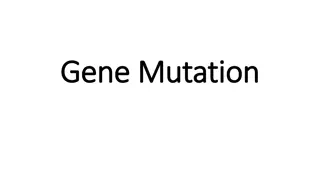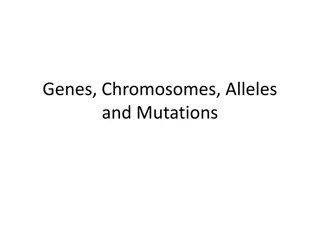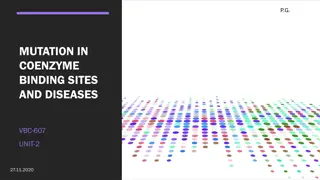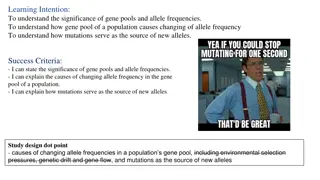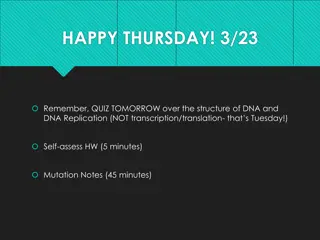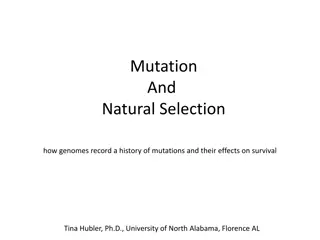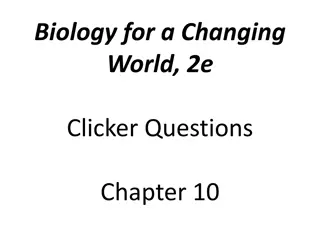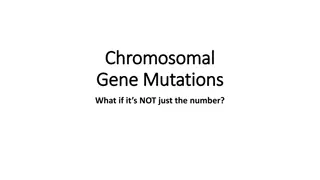Understanding Mutations in Biology
A mutation in biology refers to changes in the nucleotide sequence of an organism's genome. These alterations can either be harmful, leading to conditions like cancer, or beneficial, such as providing antibiotic resistance. Mutations can occur in somatic cells or gametes, affecting both the individual and potentially their offspring. Understanding different types of mutations like gene mutations and point mutations is crucial in comprehending the intricacies of genetics and evolutionary processes.
Download Presentation

Please find below an Image/Link to download the presentation.
The content on the website is provided AS IS for your information and personal use only. It may not be sold, licensed, or shared on other websites without obtaining consent from the author. Download presentation by click this link. If you encounter any issues during the download, it is possible that the publisher has removed the file from their server.
E N D
Presentation Transcript
In biology, a mutation is an alteration of the nucleotide sequence of the genome of an organism May occur in somatic cells (aren t passed to offspring) May occur in gametes (eggs & sperm) and be passed to offspring
Mutations can: - be bad, leading to cancer, aging, birth defects, self-aborted embryos
CACGTGGACTGAGGACTCCTC Codon for CTC = glutamate CACGTGGACTGAGGACACCTC Codon for CAC = valine What does it matter???
- be good, making an organism survive better in its environment - Example: bacteria becoming antibiotic-resistant The ability to drink milk as an adult is a helpful mutation.
Gene Mutations Change in the nucleotide sequence of a gene May only involve a single nucleotide
Types of Gene Mutations Point Mutations a. Missense b. Nonsense c. Silent Frameshift a. Insertions b. Deletions
Point Mutations A point mutation or substitution is a genetic mutation where a single nucleotide base is changed.
a. Missense Mutation This type of mutation is a change in one DNA base pair that results in the substitution of one amino acid for another in the protein made by a gene. Example is Sickle cell anemia
b. Nonsense Mutation A nonsense mutation is also a change in one DNA base pair. Instead of substituting one amino acid for another, however, the altered DNA sequence prematurely signals the cell to stop building a protein. This type of mutation results in a shortened protein that may function improperly or not at all. Examples include Duchenne Muscular Dystrophy and Thalassemia
Normal condition DNA 5 ATG ACT 3 TAC TGA CAC GTG CGA GCT GCG CGC CGA GCT AGC TCG TGA3 ACT5 mRNA GCG AUG ACU CAC CGA CGA AGC UGA Protein Met Thr His Arg Ala Arg Ser Stop
Nonsense mutation DNA 5 ATG ACT 3 TAC TGA CAC GTG TGA ACT GCG CGC CGA GCT AGC TCG TGA3 ACT5 mRNA UGA AUG ACU CAC GCG CGA AGC UGA Protein Met Thr His Stop
c. Silent Mutations Silent mutations are mutations in DNA that do not have an observable effect on the organism's phenotype. For example, if the codon AAA is altered to become AAG, the same amino acid lysine will be incorporated into the peptide chain
Frame Shift Mutations 1. Insertion Mutations An insertion changes the number of DNA bases in a gene by adding a piece of DNA. As a result, the protein made by the gene may not function properly. Example UUU UUA UCU UUU UUA UUU UCU Phe-Leu-Phe-Ser Phe-Leu-Ser
2. Deletion A deletion changes the number of DNA bases by removing a piece of DNA. Small deletions may remove one or a few base pairs within a gene, while larger deletions can remove an entire gene or several neighboring genes. The deleted DNA may alter the function of the resulting protein(s). UUU UUA UUU UCU UUU UUA UCU Phe-Leu-Phe-Ser Phe-Leu-Ser
Types of Mutations 2. Chromosomal mutation may affect more than one gene Examples: nondisjunction, translocation


